Gateway NV52 (AMD) - OS Benchmarks
The final aspect of operating system performance we want to look at involves common OS tasks. We measure how long it takes to perform the routine operations of booting, shutting down, hibernating, resuming, suspending, and waking your computer using the four test operating systems. Unlike other test results, there was a huge degree of variability in some of the tests. We ran each test at least five times, and we took the best result - the reason being that some of the results were completely out of line with the average result, so including one or two results where the system took four times as long it didn't seem logical. Ubuntu and Windows 7 didn't show as much variation as XP and Vista, particularly in the sleep/wake testing, but the hibernate/resume test once again varies quite a bit between test runs.
The variability remained even after following a relatively straightforward test procedure. First we booted each laptop using the test OS (timing how long it took). Then we let the system stabilize for at least 15 minutes, with no extra applications running and the system sitting idle at the desktop. Finally, we performed one of the other tests - shut down, hibernate/resume, or sleep/wake. Obviously, you can't test resume time without first hibernating, and you can't test wake time without first putting the system to sleep, but otherwise we made sure to shut down the system between test runs.
We also need to mention that Windows XP has an inherent advantage in the hibernate/resume testing because we are using a 32-bit OS instead of a 64-bit OS. That means the system doesn't make use of all 4GB of memory, and the hibernation file is 3GB. Writing 3GB of data will obviously be easier than writing 4GB of data, especially when you're dealing with a 5400 RPM laptop hard drive.
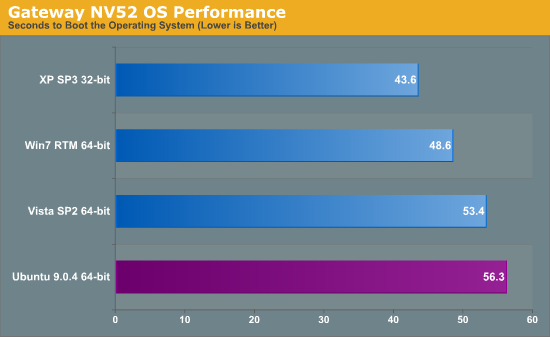
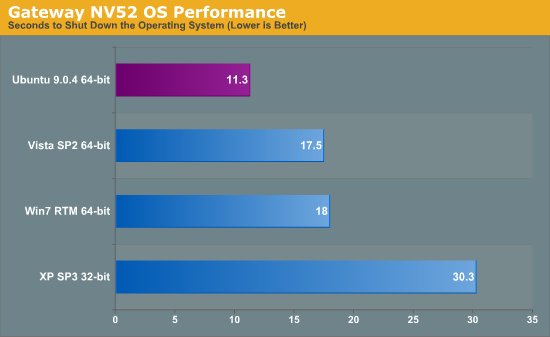
The results are rather scattered this time, with certain functions favoring one OS and others looking better on a different OS. Boot times favor Windows XP, followed by Windows 7 which takes 11% longer. Vista trails Windows 7 by 10%, and Ubuntu brings up the rear at 5% longer than Vista. Shutdown times are a different matter, where Ubuntu takes the lead. Vista and Windows 7 are essentially tied, taking 55-60% longer to shut down than Ubuntu. Windows XP brings up the rear this time, at over 2.5 times as long as Ubuntu, although we have to say that this appears to be a driver issue as the result for the NV58 is radically different. When you shut down Windows XP on the NV52, there's a delay of about 15 seconds where there is no apparent activity, after which the hard drive activity light begins blinking. It would seem that without that handicap, Windows XP would be roughly the same as Vista and Windows 7.
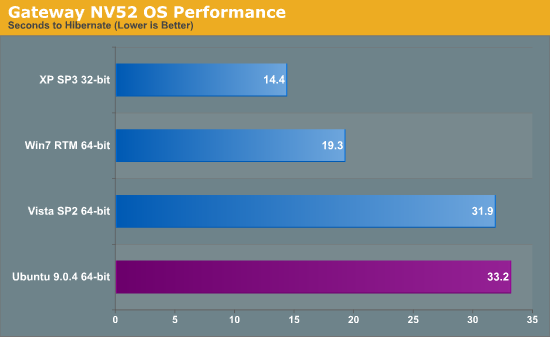
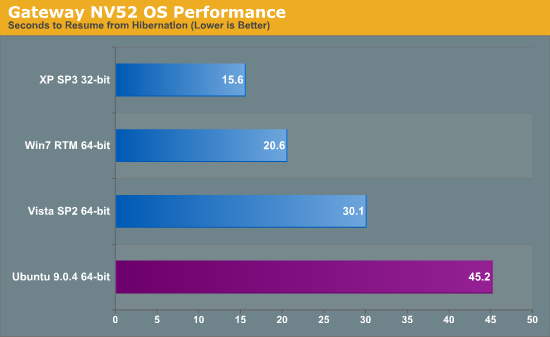
As already stated, Windows XP 32-bit has an advantage for the hibernate/resume testing because it doesn't have as much addressable RAM. It ends up walking away with the hibernate/resume performance crown, followed by Windows 7. That said, the time to hibernate in Windows 7 is 34% longer than Windows XP and resume time is 32% longer; Win7 has 33% more memory, so a 32-bit version of Windows 7 ought to be as fast as Windows XP (or a 64-bit XP as slow as Win7). The gap between Windows 7 and Windows Vista is extremely large for hibernation time, with Vista taking 65% longer to hibernate and 46% longer to resume. Ubuntu is almost tied with Vista on the hibernation time, but it takes 50% longer to resume - about twice as long as Win7 - making it by far the slowest OS for this particular test.
We need to take a moment to discuss boot times and resume times, however, as there's more going on than meets the eye. When booting or resuming a system, the computer needs to perform a Power On Self Test (POST). That takes around nine seconds on these Gateway systems, and once that's complete the boot loader is activated which then loads the OS. Ubuntu uses GRUB and that appears to add an extra ~10 seconds relative to Windows. Without that time penalty, Ubuntu would be far more competitive in boot time (about equal to Win7), although it would still be in last place in the resume test. There are also laptops that have a fast boot feature so that they don't perform a lengthy POST, which can shave another 6 or 7 seconds off the boot/resume times. This is definitely a feature we would like to see implemented on more systems going forward, particularly laptops where users routinely boot or resume several times per day.
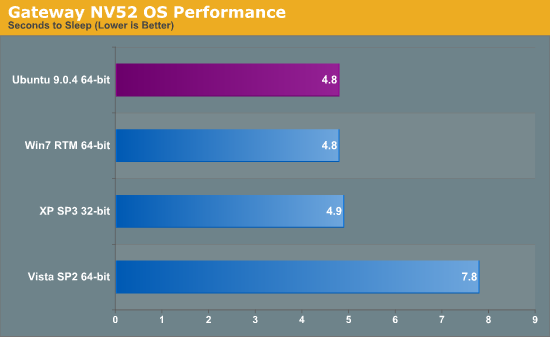
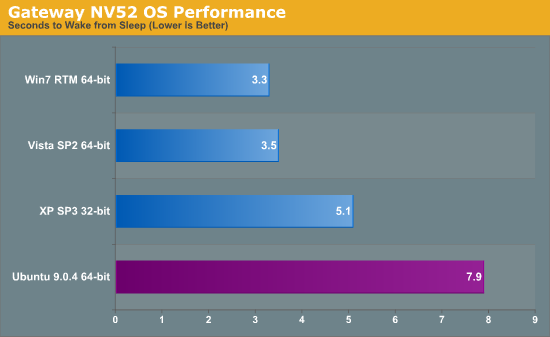
Wrapping up the OS performance analysis, the sleep/wake times were highly variable on the Windows XP and Vista operating systems. This is especially true if you put the system to sleep right after waking it up, booting, resuming, or any other complex task; in those cases, it might take over a minute to go back to sleep. Ouch! It may also take over 20 seconds for Windows to go to sleep if you have a bunch of applications open - that's about six times as long to put your laptop to sleep, which can be very annoying if you just want to pack up and go. You might think that you can just put your system to sleep and throw it in its bag and walk off, but sometimes a glitch will prevent a laptop from going to sleep so we like to make sure our laptops actually shut off before putting them in an enclosed space. We have heard of a few instances where a laptop has apparently overheated because it didn't go to sleep and a user put it in a laptop bag, resulting in a dead system. That's some food for thought anyway. Ubuntu and Windows 7 did a lot better, with the worst-case result being around twice as long as the best time.
Sleep times are a tie between Ubuntu, XP, and 7 at just under 5 seconds. Vista took noticeably longer even in our best-case result, trailing XP by 59%. Wake times mix things up quite a bit and show a lot less variation between runs, with Ubuntu falling to dead last and Vista and 7 essentially tied at ~3.5 seconds. XP takes 46% longer than Vista to wake and Ubuntu is 55% longer than XP (over twice as long as Win7). Again, though, variability in sleep times makes us prefer Windows 7 and Ubuntu followed by XP, with Vista being the worst at consistently going to sleep without a large delay.










106 Comments
View All Comments
aahjnnot - Tuesday, September 22, 2009 - link
I can't see what software was installed on the laptops. Real-world system performance is affected adversely by the installation of everyday software, and it seems highly probable that this would also affect battery life, startup times and suspend / resume / hibernate performance.It would be very interesting to see a real-world test to understand whether different operating systems are more or less affected by the cruft of daily computing. I'd suggest including anti-virus, an internet security suite, an office suite, Skype, Windows Messenger, a couple of games, itunes or equivalent, some printer drivers, some backup software and a camera management application.
JarredWalton - Tuesday, September 22, 2009 - link
The installs were all "vanilla", though I updated DirectX and installed the tested Futuremark suites on the Windows setups. In all cases, there were no Firewalls or AV software enabled. I disable automatic updates, firewall, Defender, indexing, screen savers, and set a static swap file size of 4GB. I do not try to disable any extra services, but I try to avoid any extra apps loading at start up (i.e. system tray icons that serve no real use).For Ubuntu, I just did the basic install and then tried to make it work. Easier said than done for a few areas. LOL. I manually added package repositories for Firefox 3.5, some drivers, and the necessary things to get DVD playback working. Far from a trim and speedy install, I know, but it's what Ubuntu uses by default, which means it's what most Ubuntu users will use.
aahjnnot - Tuesday, September 22, 2009 - link
I can understand why you chose a vanilla installation, but it means that your results are hardly representative of the real world. All Windows laptop users will need anti-virus; most will have a raft of additional software; and few will disable system tray entries.I run both XP and Ubuntu 9.04 on my laptop and on a couple of boxes at home. In all cases Ubuntu starts up significantly faster than Windows, and that's because cruft seems to affect Windows more than it does Linux - on my machines, a vanilla Windows installation is fast but unusable as it's insecure and has no applications.
stmok - Tuesday, September 22, 2009 - link
Which guide did you follow?JarredWalton - Tuesday, September 22, 2009 - link
This was the guide I found for the ATI platform:https://help.ubuntu.com/community/BinaryDriverHowt...">https://help.ubuntu.com/community/BinaryDriverHowt...
If their own BinaryDriver guide doesn't work, I don't have much hope for other alternatives!
stmok - Wednesday, September 23, 2009 - link
Hmmm...I see. Looking through the link you've provided leads to...Fix Ubuntu 9.04 ATI Driver Issue
http://tan-com.com/posts/technology/fix-ubuntu-904...
(This isn't a fix...Its merely being accommodating to the closed driver's deficiencies.)
Essentially, you want to stay away from ATI hardware until the open source community completes their work on the open driver for ATI solutions. ie: Waiting for xf86-video-ati driver to support your video solution. (Which will take quite a while! They're making slow progress.)
Generally, I research/pick my hardware BEFORE I install Linux. Sticking to Intel and Nvidia based solutions work best. Although, certain Intel IGPs like the GMA 500 is poorly supported. (Intel only provided a closed source driver for that particular solution).
Of course, one also has to understand that Linux is undergoing a major graphics stack re-write. (They are replacing three old components with one)...The initiative is being led by a few Intel employees and Xorg developers. This will affect recent Intel IGPs like the GMA 3xxx, GMA X3xxx and X4xxx series.
So I guess something like the Intel GMA900/950 IGPs or Nvidia supported solution are the ones to go for.
gstrickler - Tuesday, September 22, 2009 - link
Here are the conclusions I draw from this article:1. Anand/AnandTech will admit when their testing procedures are inadequate. Always a sign of a good researcher. Thanks, looking forward to updates when you find a more repeatable set of for "internet battery life"
2. Win 7 drivers may still need tuning for performance and/or battery life.
3. Win 7 battery life improvements are not likely to be the 30%+ that some vendors are claiming. You might get that much best case, but typical results will be much lower.
4. Vista sucks. Use XP or Win 7 instead.
5. Flash sucks. Ok, Flash is actually cool and useful, but it's implementation sucks. Adobe has never been known for small, fast, or efficient code.
6. Currently, Intel beats AMD in power usage/battery life.
We already knew #4-#6, and suspected #1-#3. The good news is this confirms what we already knew or suspected. The bad news it that it doesn't give us much new information.
andrewaggb - Tuesday, September 22, 2009 - link
Well I found a couple things interesting, power profiles matter but not necessarily as much as you'd think.And it had never occurred to me that disabling flash would give way better battery life. It makes total sense, but without the article I wouldn't have thought of it.
Otherwise, I agree with your analysis of 1-6
I think the actual numbers are pretty questionable, but the author admits that there is a wide variance.
Otherwise I found the linux results amusing, as well as the comments. We can only hope that people who work for canonical actually read these reviews and work to improve the usability of their products.
maveric7911 - Tuesday, September 22, 2009 - link
Of All linux distributions to use, ubuntu has so much bloat its no wonder its eating battery like that. Please use other distributions out there rather then giving the same old ubuntu bloatware benches.MonkeyPaw - Tuesday, September 22, 2009 - link
"The minimum processor state is set to 5% and the maximum processor state is 100%; we don't know how this specifically affects CPU clock speeds"It's actually pretty simple, and the feature only works with CPUs that have Powernow or Speedstep. The "Maximum Processor state" is how fast the CPU is allowed to run when the system experiences high-cpu load (which would normally increase CPU speed). For example, if you have the maximum set to 50% and you have a CPU that runs at 2.0ghz, Windows will limit the clock speed scaling to what ever multi gets it closest to 1.0ghz. I have my Toshiba notebook limit my 2.1ghz Turion X2 to 50% (1.0ghz) while unplugged to conserve battery power. Note that these percentages are not an exact science, as it's all dependent on the predefined power states (available multi's) of the CPU you're using. It is, however, a way to improve battery life if you don't mind slowing the system down a little. Personally, I don't need that much power while unplugged, but in the rare occasions that I did, I could always change power plans from the battery icon in the taskbar.